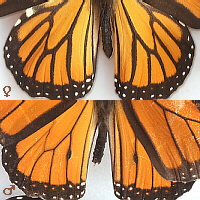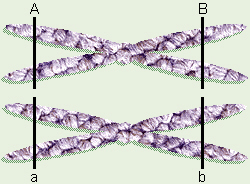Meiosis
 2-D says, “It’s actually pretty easy to tell male and female Monarchs apart.
Males have a spot on each hind wing that we females don’t have. In the photo
to the right, the top set of wings is from a female and the bottom set of
wings is from a male.”
2-D says, “It’s actually pretty easy to tell male and female Monarchs apart.
Males have a spot on each hind wing that we females don’t have. In the photo
to the right, the top set of wings is from a female and the bottom set of
wings is from a male.”
Sexual Reproduction:
In sexual reproduction, two parents give rise to an
offspring with an unique gene combination from either of them — each parent
gives ½ of his/her genes to the offspring. A
gene
is a discrete unit of information on the DNA that codes for
one protein, perhaps one of the many enzymes needed by our bodies.

Homologous Chromosomes
Somatic cells
have two sets of chromosomes; one set from each parent. For example, in
humans one set = 23 chromosomes, so our somatic cells have 46 chromosomes
arranged in 23 pairs. The two chromosomes in each pair are
referred to as being
homologous chromosomes,
so we could say that humans have 23 pairs of homologous chromosomes. The
two chromosomes of each pair carry genes for the same trait (for
example, eye color) at the same location, but not necessarily the same form
of that gene (for example, brown vs. blue eyes).
An important exception to this is the sex chromosomes,
the X and Y chromosomes. Although these chromosomes pair with each other,
they are not the same size. The X-chromosome is longer and has genes for
many traits with no match on the Y-chromosome. A person with XX would be
female and someone with XY would be male (although, that’s not true of all
other organisms). All the other chromosomes are called
autosomes.
Somatic cells have two sets of autosomes (however many pairs
that is) and one pair of sex chromosomes so are called
diploid
or 2n cells. Thus, humans would have 44 + XX or 44 + XY chromosomes,
and fruit flies would have 6 + XX or 6 + XY.
Gametes
or sex cells (eggs from female and sperm from male) have one chromosome from
each autosome pair and one sex chromosome (one set of chromosomes), thus are
called
haploid
or 1n. Human eggs would have 22 + X chromosomes,
and human sperm would have 22 + X or 22 + Y chromosomes.
Similarly, fruit fly eggs would have 3 + X chromosomes and their sperm would
have 3 + X or 3 + Y chromosomes.
Alternation of Generations:
Meiosis
is a special type of cell division that produces gametes with half as many
chromosomes. The opposite process would be
syngamy
or fertilization, which is the union of the egg and sperm to restore
the 2n number. This results in a
zygote,
the first cell formed by fertilization, a completely new and different
organism with unique genetic information different from either parent.
The zygote divides and grows to form an embryo which developes into a
young organism, then an adult.
 Life cycles of all sexually-reproducing organisms follow this pattern of
alternation of generations. The 2n adult produces 1n gametes by the
process of meiosis. These unite in the process of syngamy to produce a
new 2n generation. Thus, the life cycles alternate between 1n and 2n stages,
and between the processes of meiosis and syngamy. It is because of the way
in which genes recombine in meiosis and syngamy that we have the whole study
of genetics.
Life cycles of all sexually-reproducing organisms follow this pattern of
alternation of generations. The 2n adult produces 1n gametes by the
process of meiosis. These unite in the process of syngamy to produce a
new 2n generation. Thus, the life cycles alternate between 1n and 2n stages,
and between the processes of meiosis and syngamy. It is because of the way
in which genes recombine in meiosis and syngamy that we have the whole study
of genetics.
Steps in Meiosis:

Meiosis Animation
The steps in meiosis are similar to mitosis and even have the same names.
However, there is a significant difference in how the chromosomes line up
initially. In mitosis, chromosomes line up individually, while in meiosis,
the two chromosomes in each homologous pair line up next to each other.
This pairing process is called
synapsis,
and the resulting homologous pair is called a
bivalent
in reference to the two chromosomes or a
tetrad
in reference to the four sister chromatids involved.
Interphase is the same in both
mitosis and meiosis, but in meiosis, it is followed by two cell
divisions. These two division processes are referred to as Meiosis I
and Meiosis II, and result in a total of
four daughter cells, each with a 1n chromosome number.
In prophase I, notice the difference in how the
homologous chromosomes behave. They come together and match up (synapsis)
in pairs (tetrads or bivalents). In human females, this
stage happens prior to birth when the ovaries are forming, and then stops.
A baby girl is born with all the precursor egg cells she will ever have in a
sort-of “suspended animation” until puberty (hence abdominal x-rays are
dangerous for any young to middle-aged human female, not just pregnant women,
and hence there is a greater likelihood that a 40-yr-old mother will have a
baby with Down Syndrome – due to incorrect meiosis — than a 20-yr-old
mother).
In metaphase I, the bivalents line up, not individual
chromosomes, so there’s a 50:50 chance of which chromosome of each pair
faces which pole of the cell. Human “eggs” go about this far through
meiosis before they are shed from the ovaries at ovulation.
In anaphase I, the homologous chromosomes separate,
and one of each pair travels to each of the two poles of the cell, thereby
reducing the chromosome number from 2n to 1n. Note that the sister
chromatids stay together.
Two daughter cells are formed during telophase I.
These usually go immediately into the second cell division (meiosis II)
to separate the sister chromatids.
Meiosis II is pretty much like mitosis, in that the
sister chromatids are separated. This results in four daughter cells, each
with an 1n chromosome number. In human females, meiosis II in the precursor
egg cells never happens until/if a sperm
first enters the egg to fertilize it. Fertilization triggers Meiosis II,
and then the sperm nucleus unites with the resulting egg nucleus. Thus,
the unfertilized “eggs” that a woman sheds each month are not true eggs.
Also in human females, division of the cytoplasm is not even. This provides
a way of keeping as much cytoplasm as possible with the future egg/zygote.
Rather than equal-sized gametes, one big egg and three smaller polar
bodies with minimal cytoplasm are formed.
Interestingly, because the homologous pairs line up during
Metaphase I, there is a 50:50 chance of which one of each pair will go to
each of the poles of the cell (like flipping a coin, where you can get
either heads or tails). Therefore, in humans with 23 pairs of chromosomes,
a gamete (egg or sperm) could have 223 or 8,388,604
possible combinations of chromosomes from that parent. Any couple could
have 223 × 223 or 70,368,744,177,644 (70 trillion)
different possible children, based just on the number of chromosomes, not
considering the actual genes on those chromosomes. Thus, the chance of two
siblings being exactly identical would be 1 in 70 trillion. In addition,
something called crossingover, in which the two homologous
chromosomes of a pair exchange equal segments during synapsis in Meiosis I,
can add further variation to an individual’s genetic make-up.
Note this comparison between mitosis and meiosis.
References:
Berkow, Robert, ed. 1999. The Merck Manual. 17th ed. Merck, Sharp & Dohme, Rahway, NJ.
Borror, Donald J. 1960. Dictionary of Root Words and Combining Forms. Mayfield Publ. Co.
Campbell, Neil A., Lawrence G. Mitchell, Jane B. Reece. 1999. Biology, 5th Ed. Benjamin/Cummings Publ. Co., Inc. Menlo Park, CA. (plus earlier editions)
Campbell, Neil A., Lawrence G. Mitchell, Jane B. Reece. 1999. Biology: Concepts and Connections, 3rd Ed. Benjamin/Cummings Publ. Co., Inc. Menlo Park, CA. (plus earlier editions)
Marchuk, William N. 1992. A Life Science Lexicon. Wm. C. Brown Publishers, Dubuque, IA.

Copyright © 1996 by J. Stein Carter. All rights reserved.
This page has been accessed  times since 14 Mar 2001.
times since 14 Mar 2001.
 2-D says, “It’s actually pretty easy to tell male and female Monarchs apart.
Males have a spot on each hind wing that we females don’t have. In the photo
to the right, the top set of wings is from a female and the bottom set of
wings is from a male.”
2-D says, “It’s actually pretty easy to tell male and female Monarchs apart.
Males have a spot on each hind wing that we females don’t have. In the photo
to the right, the top set of wings is from a female and the bottom set of
wings is from a male.”

 Life cycles of all sexually-reproducing organisms follow this pattern of
alternation of generations. The 2n adult produces 1n gametes by the
process of meiosis. These unite in the process of syngamy to produce a
new 2n generation. Thus, the life cycles alternate between 1n and 2n stages,
and between the processes of meiosis and syngamy. It is because of the way
in which genes recombine in meiosis and syngamy that we have the whole study
of genetics.
Life cycles of all sexually-reproducing organisms follow this pattern of
alternation of generations. The 2n adult produces 1n gametes by the
process of meiosis. These unite in the process of syngamy to produce a
new 2n generation. Thus, the life cycles alternate between 1n and 2n stages,
and between the processes of meiosis and syngamy. It is because of the way
in which genes recombine in meiosis and syngamy that we have the whole study
of genetics.

